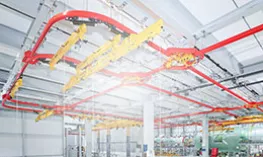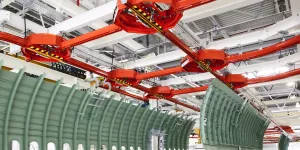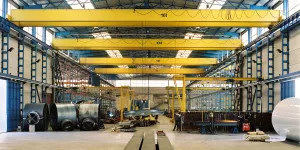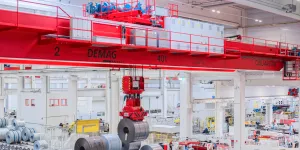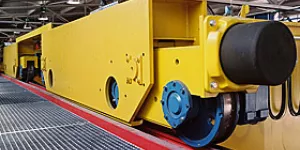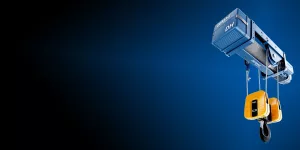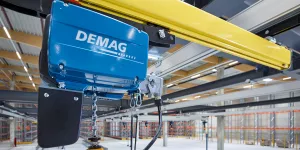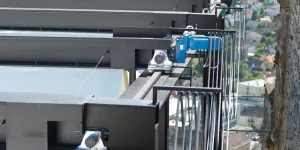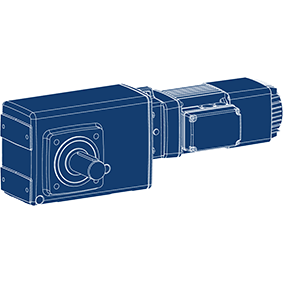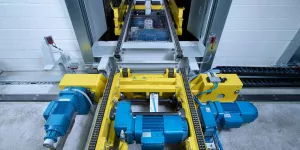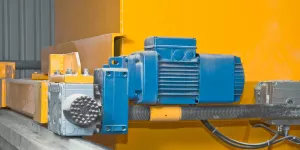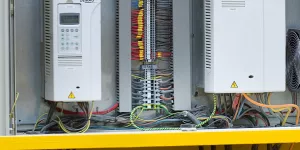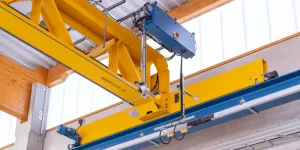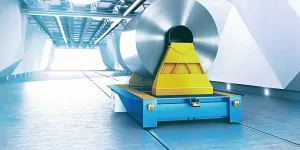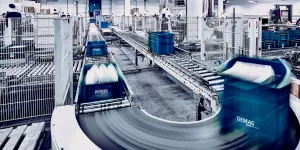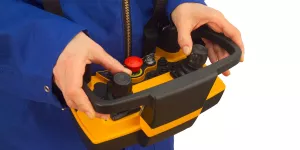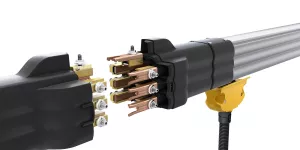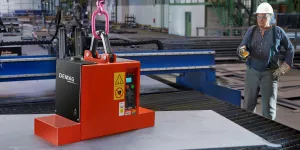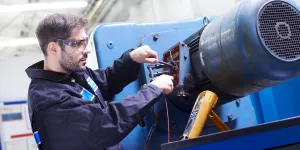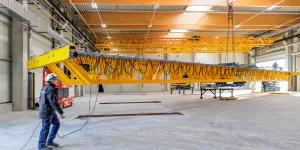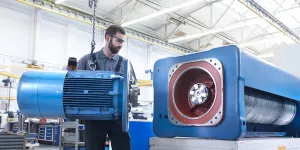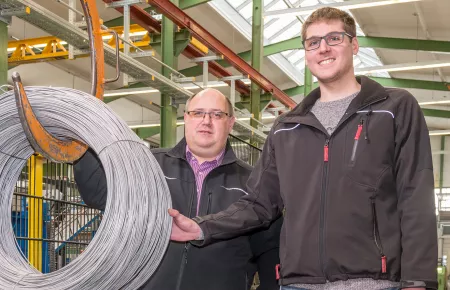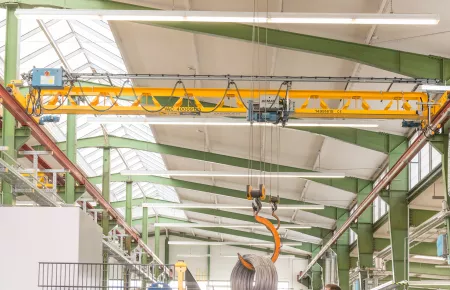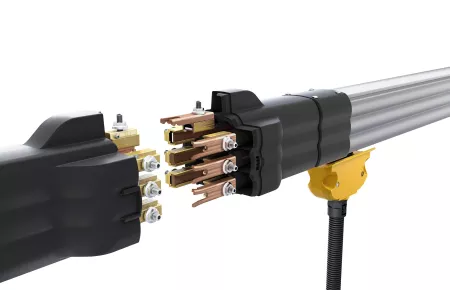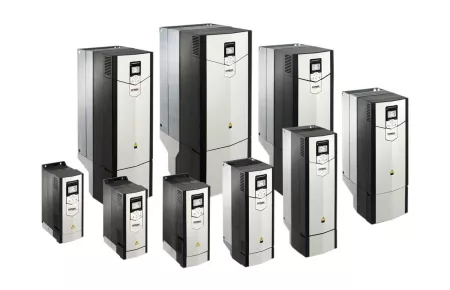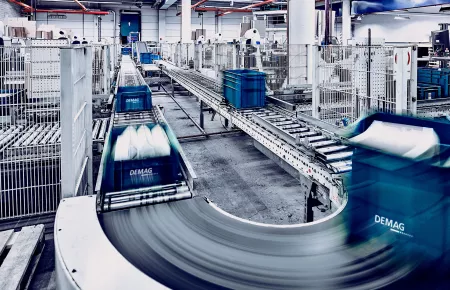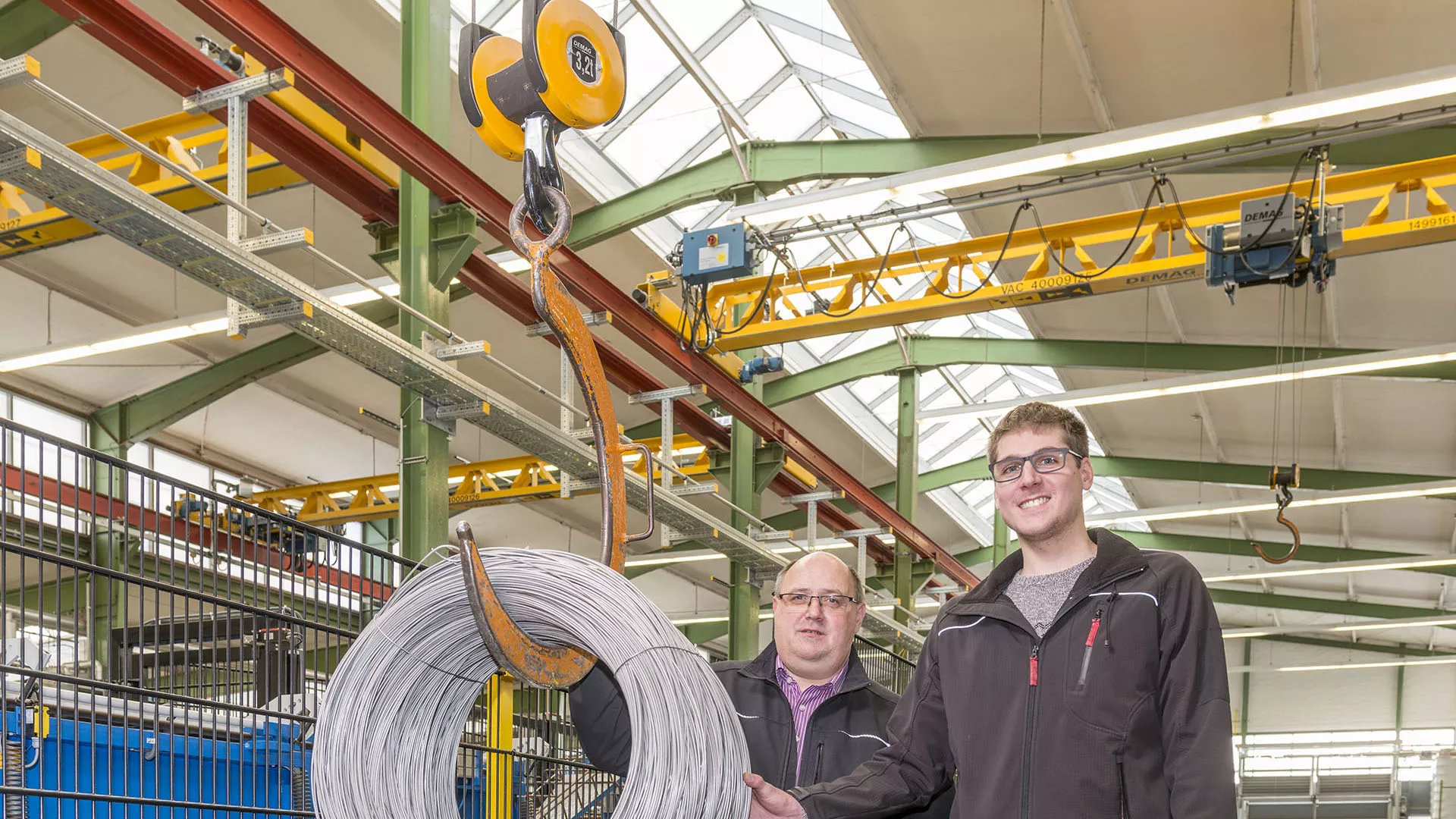
Some 350 bridge and workplace cranes in operation
Vacuumschmelze
Light weight for more performance – also for cranes
As a specialist for magnetic alloys and other special materials that are smelted in vacuum furnaces, VACUUMSCHMELZE GmbH & Co. KG offers its customers wires for demanding applications, among other products. Four new Demag V-type cranes operate in the wire drawing facility. They literally afford a better view of the working environment, enable much higher load capacities to be carried on the existing crane runways and make it possible to eliminate the need for additional workplace cranes.
What do such diverse parts as magnet cores in current sensors, control elements in glow plugs for diesel engines and springs in mechanical clocks and watches have in common? They are made from alloy wires produced by VACUUMSCHMELZE GmbH & Co. KG in Hanau, Germany. The basic alloy consisting of iron, nickel and cobalt is enhanced with additives such as chrome, molybdenum and titanium and smelted in a vacuum. In the company’s own wire drawing facility, the material is then processed to create soft magnetic wires that have defined elongation or non-magnetic spring steels.
There is demand all over the world for such special wires, which are often produced with customer-specific alloys. For this reason, VACUUMSCHMELZE restructured its production in Hanau – where some 1,450 of its global workforce of 4,500 employees work – and transferred the wire drawing facility to an existing, but fully modernised building.
Some 350 bridge and workplace cranes in operation
Previously, the workshop accommodated two crane runways that measured some 55 metres in length with a track gauge of almost nine metres. Each of them was equipped with an overhead travelling crane that had a load capacity of three tons for a deadweight of 3.2 tons. Both of these cranes dated from 1956 and were to be replaced. The goal was also to ensure long-term availability of the crane systems thanks to a reliable supply of spare parts.
Four instead of two cranes: weight-saving benefits
This was an ideal application for the new V-type cranes. Stefan Rieth, Technical Services at VACUUMSCHMELZE: “Since a V-type crane only weighs little more than half as much as one of our old lattice-girder cranes, we were able to install two cranes on each runway.” This brought several advantages: “At various parts of the installation, there were also pillar-mounted slewing jib cranes that needed to be replaced, too. To achieve this, we would have needed to integrate new foundations in the modernised building. However, in view of the difficult ground conditions, this would have been very complicated and expensive. By doubling the number of overhead travelling cranes, we were able to eliminate the need for this investment without having to accept any limitations for handling loads. And we also realised an additional backup, since one crane can take on the tasks performed by the other one, if necessary.”
The weight benefit and, therefore, the advanced design are clearly evident: one of the previously installed lattice-girder cranes had a deadweight of 3.2 tons for a load capacity of 3 tons. In today’s constellation, a Demag V-type crane can lift 3.2 tons – and weighs just 1.7 tons. The loads and forces acting on he crane runway have also been significantly reduced.
Improved oscillation characteristics, longer service life
In addition, the new V-type design, which was launched in 2014, also provides a 30% improvement in oscillation characteristics. For the operator, this means that loads settle more quickly and the entire process benefits from faster and, at the same time, safer and more reliable load handling: the rolls of wire, which are mostly picked up by a C-shaped hook, can be quickly transported and precisely positioned.
The increased service life of up to 500,000 changes of load is not only an advantage in terms of a good long-term investment. It also indicates that the amount of maintenance work required for V-type cranes has been minimised at the same time.
Radio control as standard
The decision-makers at VACUUMSCHMELZE opted for four identical V-type cranes that have a span of 8.97 m. Power is supplied to the cranes through the Demag DCL-Pro compact conductor line. This light-weight system is installed parallel to the crane runway for a reliable power supply.
The four cranes are equipped with the new D3 radio control system. Manuel Pfeifer, Technical Services* at VACUUMSCHMELZE: “Initially, we were slightly sceptical about using radio control, as a fairly large number of workers have access to the cranes. They need to be disciplined and always put the radio control units back at the same place. In practice, this works very well and my colleagues appreciate the fact that they can always adopt the best position for a good view of the load.”
More light and improved safety
Although the old cranes which were replaced had lattice girders and appeared to be much “lighter” than cranes that have box-section girders, they were much higher and more solid than state-of-the-art V-type cranes, which have very lean structural elements. Manuel Pfeifer: “Our colleagues in the department were really surprised that this comparatively delicate profile-section design is able to support even heavier loads than the old cranes. Another positive aspect is the fact that the profile sections allow more light to pass through. Our workshops are now brighter and the shadows cast by the cranes have been significantly reduced. This is particularly apparent in comparison with conventional enclosed box-section girders.”
From the point of view of the service staff in Hanau, the V-type cranes also offer improved safety for maintenance and inspection work. Stefan Rieth: “Our service technicians report that they feel safer, because they have a view of the entire workshop and do not have to work behind a solid girder, where they cannot be seen.” With reference to service: some 350 cranes – including approx. 60 overhead travelling cranes – are installed in the facilities operated by VACUUMSCHMELZE in Hanau. They are regularly maintained by the specialists from Demag Service. Stefan Rieth: “Together with Demag Service, we have developed a maintenance schedule for all of our cranes at this site. It is designed to cater to the level of use of the individual crane systems and also covers the maintenance of our high-bay warehouse and first-line repairs for our powered industrial doors. Our goal is to determine our needs in good time through preventive maintenance to minimise any subsequent costs.”
Transparent operating costs – regardless of the location
The decision-makers at VACUUMSCHMELZE have also taken a new approach towards the monitoring and availability of crane installations with StatusControl. This system gives the owner and also Demag Service, whose service technicians are constantly on site and look after all crane systems, continuous access to the service-relevant operating data of the cranes – regardless of their location. The cranes are equipped with Demag StatusControl, which provides remote access in real time to crane data, also from mobile devices such as tablet computers. The system can be used to view equipment status information and generate reports, as well as to monitor and document specific operating data.
The information recorded and provided by the system enables maintenance work to be optimised, indicates potential faults and improves compliance with all safety regulations. And this information can be evaluated at a glance: a simple traffic-light system indicates whether individual parameters show cause for action to be taken or everything is OK. Stefan Rieth: “We embraced this new technology from the very start and it now gives us a realistic evaluation of how long crane equipment has been in operation. Demag StatusControl is an important element of the predictive maintenance with which we ensure the lasting availability of our cranes.”
Long service life expectations
Since they were installed, the four V-type cranes have been working smoothly and, with an expected service life of up to 500,000 changes of load, they will be in operation for a long time, since they are not in continuous use. A long service life is also in line with their owner’s expectations: their predecessors were only replaced after 56 years.

